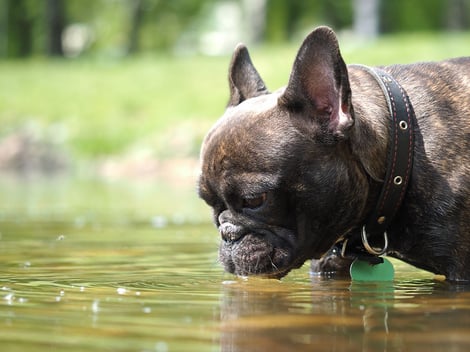Understanding and Preventing Leptospirosis in Dogs

Leptospirosis—sometimes shortened to lepto—is a dangerous bacterial disease that can be especially harmful to small dogs.
Leptospirosis is spread through contact with Leptospira bacteria, usually found in soil and water that has been in contact with urine (pee) from an infected wild animal.
Unfortunately, lepto is becoming more common these days due to climate disruption, weather patterns, and changing wildlife habitats.
Leptospirosis has a host of symptoms, and it can result in kidney failure and death. It can also be spread to people.
Pet parents need to take the threat of lepto seriously and learn how to protect our pups, especially the more susceptible small breeds.
What Causes Leptospirosis?
Lepto used to be considered a problem for country dogs, especially in warm, rainy climates. But things are changing.
According to an article in Veterinary Practice News, lepto cases are on the rise because more and more pets are sharing their environments with infected animals, including mice, rats, skunks, deer, opossums, and raccoons. These infected animals are called carriers because they carry the bacteria and spread the bacteria to other animals through their urine.
As these wild creatures find their way into cities and suburbs, they spread the tiny germs called leptospires when they pee on grass, sidewalks, and pools of water. When dogs lick the contaminated grass or sidewalk, or when they drink the contaminated water, they can become infected. This can lead to deadly results.
The American Veterinary Medicine Association (AVMA) lists the following risks for dogs getting leptospirosis:
- Drinking from rivers, lakes, or streams
- Roaming in the country
- Interacting with wild animals or farm animals
- Contact with rodents (rats or mice) or eating their infected carcasses (dead bodies)
- Exposure to infected dogs at dog parks or other places where dogs get together
Regional and Seasonal Differences
The leptospires survive best in moist environments.
Lepto used to be more common in the Southeast and South, the Pacific Northwest, and the Northeast. It’s also a problem in areas that are prone to flooding, like places along the Mississippi River.
But these days, even drier places like Phoenix, Arizona, experience outbreaks because many people water their lawns to keep them green.
Depending on where you are in the U.S., cases of lepto tend to be identified in fall or early winter, maybe because raccoons and other animals look for shelter in colder months, and that can bring them closer to where dogs hang out.
Small Dogs Beware
Justine Lee, a veterinarian in Minnesota, says she sees at least one to two cases of lepto per week at an animal ER located in the city, and many of them are small terrier types.
Another vet, George E. Moore, of Purdue University College of Veterinary Medicine, reported that dogs under 15 pounds were more likely to be diagnosed with leptospirosis because they’re less likely to be vaccinated against the disease. Some small dog breeders may recommend against vaccination, but that should be changing now that lepto vaccines are safer than ever before.
Symptoms of the Disease
Lepto is a tricky disease to diagnose. Not all vets are familiar with it because it wasn’t common in their location before. Many symptoms overlap with other health problems. And some dogs with lepto die suddenly without any warning signs at all. Truly scary for pet parents (and vets)!
There are many other diseases that can cause the following health problems, so don’t try to make the diagnosis yourself. This is a list of signs that your dog may have leptospirosis.
- Vomiting
- Abnormal bleeding: blood in vomit, pee, poop, or saliva, or nosebleeds
- Anorexia (too thin)
- Lethargy or reluctance to move
- Muscle pain, stiffness, or tenderness
- Fever (a dog’s temperature is normally higher than that of a person)
- Eye problems due to inflammation in the eye
- Jaundice (yellow color to the eyes, lips, and gums)
- Swollen legs, chest, or abdomen due to fluid buildup
- Pee a lot and drink more than usual
Dr. Lee says pet owners and vets should put leptospirosis on their list of possible diseases when a dog pees a lot and drinks a lot because lepto causes injury to the kidneys, and kidneys help maintain the fluid balance in the body.
Testing and Treating Leptospirosis
If you or your vet thinks that your dog may be infected with lepto, your vet will likely recommend some of the following tests:
- A physical examination
- Blood tests
- Urine tests
- X‑rays
- Ultrasound
- Antibody and/or PCR (bacterial DNA) testing
If your dog is diagnosed with leptospirosis, your vet will likely start them immediately on antibiotics to knock out the bacteria. Some dogs will require IV fluids and nutritional support. The unlucky dogs that get severe cases may need oxygen, ventilators, or kidney dialysis.
Those invasive treatments can be very expensive (hundreds to thousands of dollars), so it’s always a good idea to contact your vet early on to discuss treatment options.
In people, leptospirosis causes flu‑like symptoms and can lead to liver or kidney disease. Most people don’t get it from their pets, but if your pet has lepto, you’ll need to be careful if you touch their pee (see below).
And, as with many diseases, prevention is the best medicine, and usually the cheapest.
5 Steps for Preventing Lepto in Dogs and Humans
- Vaccinate. There is an effective vaccine for leptospirosis that lasts for 12 months. It is not part of the core vaccines recommended by the American Animal Hospital Association, and the current recommendation is for “at‑risk” dogs. But now that leptospirosis is increasing, more dogs are at risk. That’s why I’d recommend vaccinating your dog.
- Secure the garbage. Many of the creatures that carry lepto (rats, raccoons) love to feast on human food and garbage. To avoid luring them into your yard, make sure you aren’t accidentally providing them with tasty snacks.
- Avoid contaminated water. If it’s possible, stop your dog from swimming, wading in, or drinking water that could be contaminated, especially water or marshy areas where the water isn’t flowing to flush out the leptospires.
- Minimize contact with wild creatures and farm animals. Don’t let them munch on dead mice or rats, whether or not they think they’re delicious.
- Avoid contact with your dog’s pee. This is especially important if they have been diagnosed with leptospirosis. Wear gloves and use a disinfectant to clean up urine. And wash your hands after handling your pet.

